
mm-Wave E-band Marine Radar FAQ
CONTENTS:
1. What is the main purpose of E-band short-range marine radar?
2. What is the detection range of E-band ultra-short-range marine radar?
3. What is the blind spot of a 76 GHz E-band marine radar?
4. What does the term FMCW mean in marine radar characteristics?
5. What is a size of a smallest target for E-band marine radar?
6. What is the difference between S-band, X-band, K-band, and E-band marine radars?
7. What are the advantages of radar E-band vs. K-band radar?
8. Is a zero blind spot possible for E-band marine radar?
9. What are the advantages of the FMCW 76 GHz E-band marine radar?
10. What are the disadvantages of the 76 GHz E-band marine radar?
11. Can a 76 GHz E-band marine radar see a boat made of carbon or wood?
12. Why is it recommended to put radar reflectors on small boats?
13. Can 76 GHz E-band maritime radar detect targets exactly under the high side of large ships?
14. Can E-band 76 GHz marine radar be used for automated mooring assistance?
15. What are the benefits of 76 GHz E-band marine radar for autonomous ships?
16. Can you use 76 GHz E-band marine radar for commercial drone boats?
1. What is the main purpose of E-band short-range marine radar?
The E-band marine radar is intended to work as the obstacle sensor for installation on any vessel which operates under poor visibility conditions. This especially includes tugs, rescue vessels, ocean-class yachts, ferries (including high-speed ones), cruise ships, gas carriers and other vessels with dangerous goods, icebreakers and ice-class commercial ships, as well as any vessels with an automated collision-free navigation system or almost driverless autonomous ships.
Another radar application is navigating through the marina or port waters to bring vessels, including large yachts to the mooring safely. The radar has a digital output for integration with the vessel’s auto-steering system. This allows automatic mooring with high precision manoeuvring.

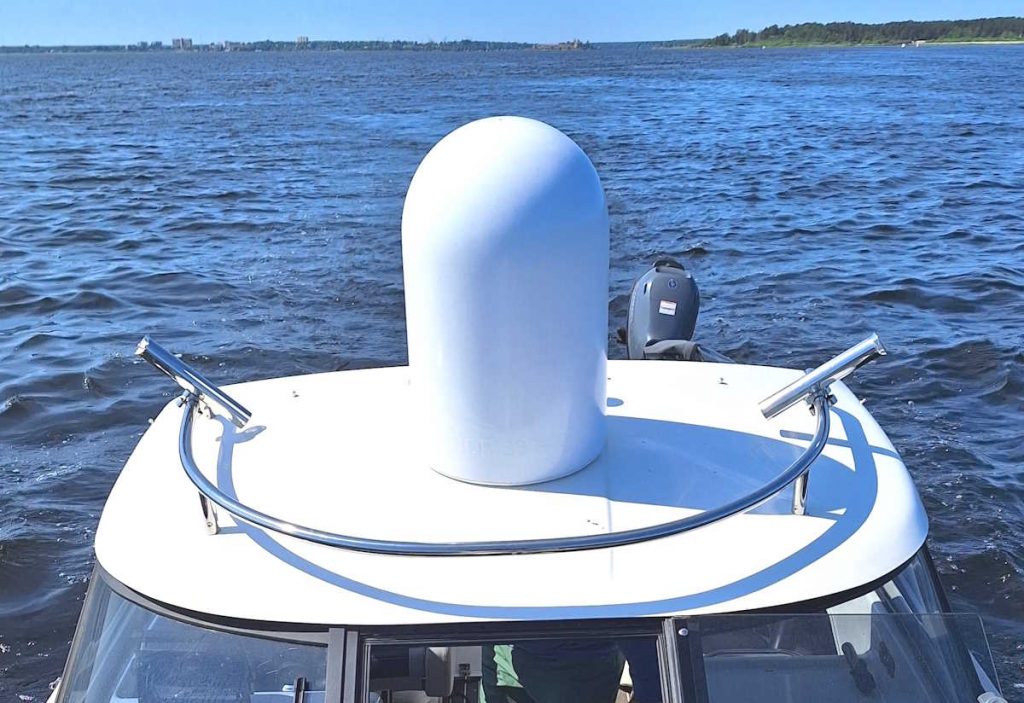
2. What is the detection range of E-band ultra-short-range marine radar?
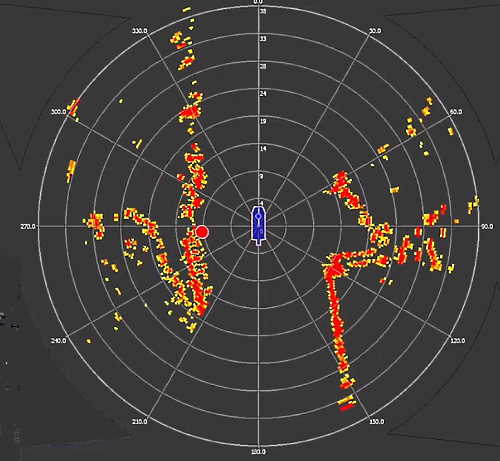
SDM360-76 radar measures the distance between your vessel and possible obstacles (other vessels around, port facilities, coastline, rocks, etc.) within the max range from 0 to 600 m (0-0.324 nmi) with high accuracy of ±7.5 cm. The range can be changed by radar software, for example, set to 0-300 m (0 to 0.162 nmi) or to as low as 0-100 m (0-0.054 nmi) depending on the current environments around and the size/speed of the vessel. The shorter the range of the radar is, the more detailed picture it shows.
ELVA-1 SDM360-76 E-band radar’s task is to show the detailed radar picture as closely around the vessel as possible, not to look for distant targets. For long-range target detection, the S-band and X-band radars have to be used.
3. What is the blind spot of a 76 GHz E-band marine radar?
The radar has a zero blind spot, and such characteristics are very valued in the industry. The ability to see a radar picture within a few meters of the side is especially important for offshore tugboats that help in the mooring of large vessels with dangerous cargo such as liquefied natural gas (LNG).
There are other tasks in which the absence of a short-range radar blind spot is of great importance. This is, for example, the icebreaker’s work on skirting the ice around the escorted vessel. This requires the icebreaker to pass almost exactly along the side of the escorted vessel. When breaking up ice in the sea or river, there is often very strong steam over the water, and it is difficult for the helmsman to know how close the icebreaker is to the other vessel and prevent a collision. Neither video cameras nor laser rangefinders will help here because of the fog and steam. Only E-band radar can do the job.
4. What does the term FMCW mean in marine radar characteristics?
FMCW radar (Frequency-Modulated Continuous Wave radar = FMCW radar) is a special type of radar sensor which radiates continuous transmission power. FMCW radar means this radar has a continuously frequency-modulated signal in a wide band. This type of radar is used to measure distances over short distances with high accuracy and no blind zone (also called a radar dead zone). This differs from pulse-based navigational radars so that ELVA-1 E-band radar can monitor the approach to an obstacle directly to the side of your vessel.
The main component of the SDM360-76 is a continuously rotating millimeter wave sensor based on the FMCW principle of the operation. FMCW millimeter sensor is made according to the scheme with homodyne reception with spatially spaced receiver and transmitter. The principle of operation of the radar of this type is based on obtaining the necessary information about the object, expressed in terms of the delay time of the reflected signal relative to the probing signal.
The simplified structural diagram of FMCW-radar, explaining the principle of operation is shown in the figure below.
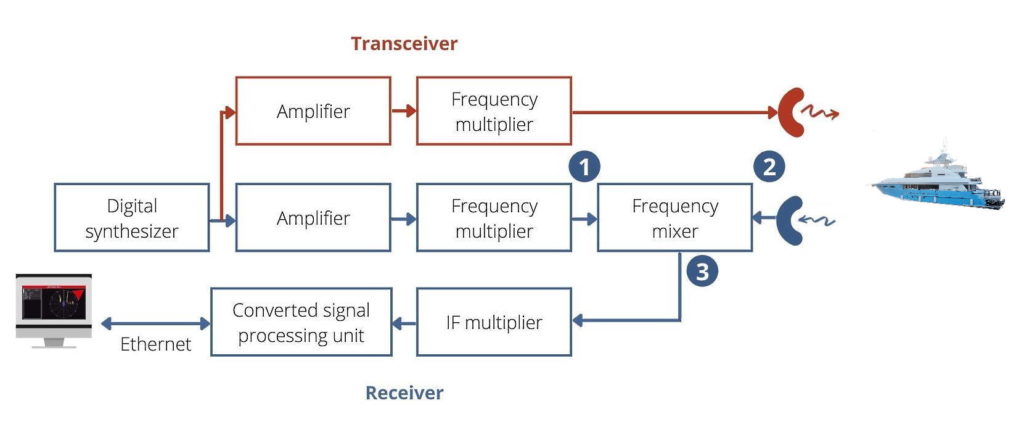
5. What is a size of a smallest target for E-band marine radar?
To eliminate interference from wave glare and obtain a more informative radar picture of the ship’s surroundings, the radar software applies different techniques and adjusts the accuracy within certain limits. The ELVA-1 SDM360-76 radar is typically configured to show targets the size of a navigation buoy or larger on its screen. However, the min size of the target can be adjusted as desired by customer, e.g. for a rescue boat it can be set to an object with dimensions like a swimmer or a floating lifejacket.
6. What is the difference between S-band, X-band, K-band, and E-band marine radars?
The most common maritime radars are S-band (3 GHz) and X-band (10 GHz). There are also high-frequency high-resolution FMCW radar models of K-Band (24 GHz) and E-band (76 GHz). which give much higher levels of situational awareness in densely populated marine environments.
- The S-band is a radar frequency range that uses short waves in the frequency range from 2 to 4 GHz. S-band radars are used to detect other ships and ground obstacles, to determine bearing and distance for collision avoidance and navigation at sea. Typically, 3 GHz frequency is used as an emission carrier for long-range maritime radars.
- X-band radars are installed on most large ships and on many offshore installations. They are used for ship traffic control and navigation. X-band is a segment of the microwave part of the electromagnetic spectrum in the frequency range of 8-12 GHz. Typically, 10 GHz is the frequency used for maritime radar. Examples of many X-band and S-band radars can be found on the Furuno website.
- K-Band radar (24 GHz) – the K-band is part of the radio spectrum in the microwave frequency range of 18 to 27 gigahertz (GHz). It is mostly referred to as the IEEE K-band to distinguish it from the complementary bands Ku-band (12-18 GHz) and Ka-band (27-40 GHz). The radar signal in the K-band center frequency range between 18- and 26.5 GHz is absorbed by water vapor in the atmosphere because of the resonant peak at 22.24 GHz (1.35 cm wavelength). These frequencies experience high atmospheric attenuation and cannot be used for long-range radar applications. On the other hand, maritime K-band radars have low power and small size, allowing them to be used on small vessels. Example is Wärtsilä RS24 K-Band radar (24 GHz).
- E-band (76 GHz) radar is the latest technology advancement in the maritime radar industry. The E band represents the frequency range from 60 GHz to 90 GHz. The frequency of around 76 GHz is allowed for unlicensed use for collision avoidance applications in the transportation industry. This type of radar provides high-resolution situational awareness for accurate navigation and safe manoeuvring in harbours, fjords and locks. With this radar, the helmsman can easily identify and locate small vessels or navigational buoys on the screen.
The higher the frequency, the better the resolution of the radar, but the lower the range. For example, 76 GHz E-band and 24 GHz K-band, being a higher frequency, are used for clearer images and better resolution within a range up to 0.5-2 nautical miles, while S-band is used especially for long range obstacles surveillance for identification and tracking.
A very important advantage of E-band radars is a very low radiated power, which is safe for people and the environment. For example, for ELVA-1 SDM360-76, this power is 100 mW (0.1 W), which is even lower than the transmitting power of iPhone (up to 300 mW for the latest iPhone models, and up to 2000 mW for old iPhone models).
7. What are the advantages of E-band radar vs. K-band radar?
Let’s start with the presence of a small blind spot for K-radar, while it has not for E-band radar.
E-band radar, – consider other things being equal in antenna size and radiated power with K-band radar, – offers better elevation angle resolution. Plus, E-band radar range resolution is up to 5 times better. In general, the E-band radar picture is clearer both in angle and range. This is because the allocated unlicensed band in K-Band is 200 MHz, while in E-Band it is 1000 MHz, which allows us to obtain significantly higher resolution.
The experience of ELVA-1 E-band marine radar testing in a large port in the Barents Sea has shown that in the harbor waters, ships always move slowly and helmsmen pay max attention to nearby obstacles. The most demanded range scale within harbor is 0-100 m, while ranges of about 1 mile are practically unclaimed because are covered by the use of X-band or S-band radar, always available on the ships.
8. Is a zero blind spot possible for E-band marine radar?
The radar software uses the ship’s contour data and the geometric position of the radars on board to mathematically calculate the distance from the vessel to the target. To eliminate blind spots on large vessels, two or more radars mounted on opposite sides of the vessel forward and aft should be used.
When more than one radar is used on a vessel, a consolidated radar picture is provided to the operator. In addition, a proximity warning is displayed with a heading to the nearest obstacle (indicated by a red dot on the screen), and an audible alarm may be activated to warn of an obstacle.
To ensure maximum control area, the SDM360-76 radar (or a few radar units) has to be installed on the deck of the vessel in such a way as to exclude shading by a lifeline, railing, bulwark, etc. No shading elements are allowed within ±10 degrees of the horizon at the height of the central part of the protective radome.
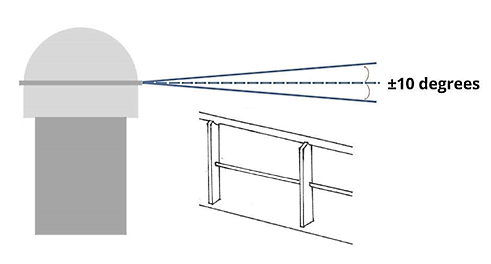
9. What are the main advantages of the FMCW 76 GHz E-band marine radar?
The FMCW E-band high-speed dome radar has the best resolution of any other type of maritime radar. Digital output allows radar images to be displayed both on the dashboard and in third-party applications that support an open data format.
For an example of E-band radar benefits, consider the features of ELVA-1 SDM360-76 radar:
- Maximum range 0 to 600 m (0-0.324 nmi)
- Typical operation ranges 0 to 300 m (0 – 0.162 nmi) or 0-100 m (0-0.054 nmi)
- No radar blind spot
- High-resolution situational awareness with 0.15 m accuracy
- Detailed output radar images to the dashboard
- Data transfer to 3rd party app which supports the open data format
- Navigation through narrow waterways, at night and fog
- Identification of small boats, buoys, port infrastructure and coastline
- Dome design with 30 RPM antenna rotation
- Radiation power 100 mW
- Total on-board power consumption 100 W
10. What are the disadvantages of the 76 GHz E-band marine radar?
The disadvantages of the 76 GHz E-band maritime radar are mainly related to the markedly higher cost in the market niche of near-field radar sensors. The high emission frequency requires more expensive components than for 3 GHz or 10 GHz radars. At the same time, high-powered S-band (3 GHz) and X-band (10 GHz) shipborne radars are many times more expensive than 76 GHz E-band radar.
Also, compared to conventional X-band pulse navigation radar, millimeter wave E-band radar has a much shorter range, which is its functionality, not a shortcoming.
The presence of high waves on the water surface is detected by E-band radar as targets. Therefore, the main purpose of the radar is maneuvering in calm waters such as bays, marinas, harbors and port waters, locks and fjords.
11. Can a 76 GHz E-band marine radar see a boat made of carbon or wood?
A fiberglass boat (carbon boat) is the most difficult object in terms of radar detection. Fiberglass is an almost radio-transparent material and even is used for radar radome. But due to the high radar frequency, there are always glare spots on the fiberglass boat, such as from the engine and the rigging and deckhouse components, that will allow you to detect a fiberglass boat using E-band marine radar.
Regarding a wooden boat, you can consider it as a more radio detectable target and allows you to identify it not by radio signal glares, but by reflection from the boat hull.
We at ELVA have compared the radio transparency of plywood and fiberglass:
- 8 mm plywood absorbs 7-8 dB of signal,
- 5 mm fiberglass attenuates the signal by only 2-3 dB, depending on the fiberglass material.
So, there is a significant difference in detection of fiberglass and wooden boat. But both types of such kind of boats can be detected by E-band radar.
12. Why is it recommended to put radar reflectors on small boats?
Radar reflectors are metal polygons that help small boats appear on the radar screens of larger boats. Radar reflectors are usually required for boats that are less than 20 meters (65.6 feet) in length and especially those whose hulls are made of plastic or wood rather than metal.
In practice, the radar reflector should be mounted on a mast where it is at least 4 m (13.1 ft) above the waterline and above all surrounding superstructures. The height at which the radar reflector is suspended is critical to ensure that your boat will be visible on the radar screen of large ships, speedboats, and fishing boats. You can purchase a radar reflector from companies that sell boats and boat accessories.
13. Can 76 GHz E-band maritime radar detect targets exactly under the high side of large ships?
76 GHz E-band radar requires a line of sight to possible targets to detect them. Large ships, such as cruise ships, have a high-side V-shaped hull, so multiple E-band radar units need to be mounted along the sides.
To ensure maximum control area, the SDM360-76 radar has to be installed on the deck of the vessel in such a way as to exclude shading by a lifeline, railing, bulwark, etc. No shading elements are allowed within ±10 degrees of the central part of the protective radome.
14. Can E-band 76 GHz marine radar be used for automated mooring assistance?
Yes, this radar application is possible. However, automated mooring includes many difficulties associated with maneuvers. Unlike automatic parking of a car on a street, automated mooring of a ship is the extremely complicated procedure by the high inertia of motion, and the influence of wind and water currents. Therefore, fully automatic vessel mooring is still an experimental area of engineering research.
15. What are the benefits of 76 GHz E-band marine radar for autonomous ships?
The latest high-resolution radar technology is an integral component of any autonomous ship project. An autonomous ship navigation system requires an accurate instrument to detect and track near- and far-zone targets.
Therefore, autonomous ships need to have radars of different bands, for example, S-band and E-band radars working together to maintain situational awareness and allow to plan the trajectory in advance to reduce collision risk.
16. Can you use 76 GHz E-band marine radar for commercial drone boats?
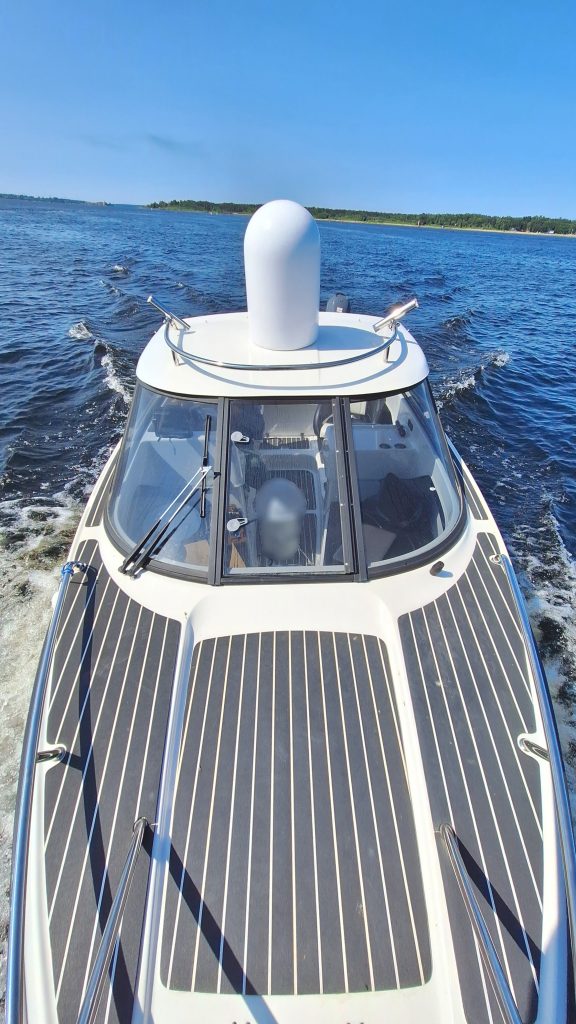
A drone boat is different in size and the tasks it performs than an autonomous ship. Drone boats are small and perform tasks in local waters, - for example, they are most often assigned the function of delivering of small loads. Drone boats also can be used for monitoring certain waters where the using of a similar boat with a crew can be too expensive or dangerous for the crew for a variety of reasons. E-band radar allows drones to navigate safely with very high accuracy, and an operator can observe the radar picture for control of the drone in remote mode.
On the photo: 76 GHz SDM360-76 Marine Radar on autonomous drone boat
Autonomous vessels have a different transportation mission; they move large loads over long distances, replacing similarly sized, crewed vessels. Autonomous ships need radars of different classes and bands, while drones only need a compact E-band radar.
E-band marine radar booklet
ELVA-1 ultra short-range E-band 76 GHz marine radar intro
In 2022, ELVA-1 introduced the industry’s first ultra-short-range E-band 76 GHz marine radar, designed to provide a high level of situational awareness in harbour waters, densely populated marine environments, and narrow passages among rocks and for safe navigation nearby of other obstacles. The radar has SDM360-76 model name, is built on FMCW design, and operates in millimeter wave band with a 4 mm wavelength allowing it to detect very small targets.
E-band radars can be installed not only onboard ships/boats but also on port berths for vessel traffic service operated by the harbour or port authorities. This will allow 24×7 monitoring of port area waters for the position of ships in the harbour/marina, and movements of vessels when approaching the berths, including assisting in the mooring and towing of ships and barges.
The main advantage of short-range E-band 76 GHz marine radar is the complete absence of a blind spot. Several radar units can be installed at different locations on the vessel and the software will allow displaying the situation along the contour of the vessel.
The resolution of ultra-short-range E-band 76 GHz marine radar is 0.15 m, which is up to 100 times better than existing S-band (3 GHz) and X-band (10 GHz) marine radar systems and even better than the latest K-band (24 GHz) radars. With a rotation cycle of 30 rpm, this allows for an exceptional resolution to separate small targets like boats in crowded waters, especially near the vessel to navigate safely. The radar system is designed to identify the nearest potential hazards, provide a distance and direction to the nearest of them and create a highly accurate map of the work area.
To better acquaint our leads and customers with the features of ELVA-1 ultra-short-range E-band 76 GHz marine radar, a list of FAQs about SDM360-76 radar system has been compiled. Before you read the FAQ section, check out how marine E-band 76 GHz radar works on a harbour tug and a private boat in these videos.

